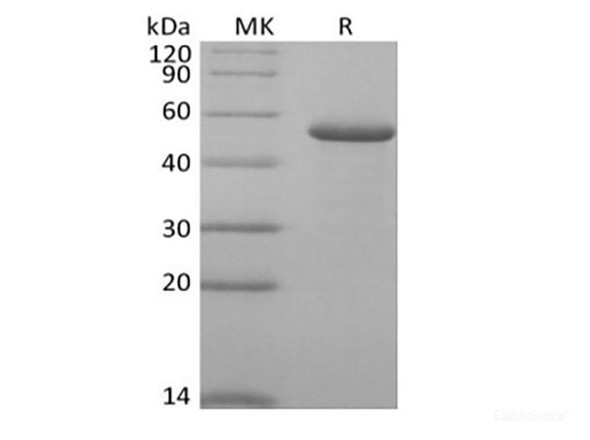Description
| Product Name: | Recombinant Human B4GALT1 (C-6His) |
| Product Code: | RPES6249 |
| Size: | 10µg |
| Species: | Human |
| Expression Host: | HEK293 Cells |
| Synonyms: | 1,4- galactosyltransferase, polypeptide 1, B4GalT1, B4GAL-T1, beta-1,4-galactosyltransferase 1, Beta-1,4-GalTase 1, beta4Gal-T1, betaGlcNAc beta, CDG2D, GT1, GTB |
| Mol Mass: | 40.1 kDa |
| AP Mol Mass: | 50-60 kDa |
| Tag: | C-6His |
| Purity: | > 95 % as determined by reducing SDS-PAGE. |
| Endotoxin Level: | < 1.0 EU per μg of the protein as determined by the LAL method. |
| Bio Activity: | Testing in progress |
| Sequence: | Gly44-Ser398(Tyr285Leu) |
| Accession: | P15291 |
| Storage: | Store at < -20°C, stable for 6 months. Please minimize freeze-thaw cycles. |
| Shipping: | This product is provided as liquid. It is shipped at frozen temperature with blue ice/gel packs. Upon receipt, store it immediately at < - 20°C. |
| Formulation: | Supplied as a 0.2 μm filtered solution of 20mM Tris-HCl, 150mM NaCl, pH 8.0. Normally 5 % - 8 % trehalose, mannitol and 0.01% Tween80 are added as protectants before lyophilization. Please refer to the specific buffer information in the printed ma |
| Reconstitution: | Not Applicable |
| Background: | Beta1,4-Galactosyltransferase-I (B4GALT1), one of seven beta1,4-galactosyltransferases, is an enzyme commonly found in the trans-Golgi complex that adds galactose to oligosaccharides. By sequence similarity, the beta 4GalTs form four groups: beta 4GalT1 and beta 4GalT2, beta 4GalT3 and beta 4GalT4, beta 4GalT5 and beta 4GalT6, and beta 4GalT7. beta 4GalT1 is unique among the seven enzymes because it can be expressed either as membrane associated form or secreted form. The secreted form is restricted to lactating mammary tissues where the enzyme forms a heterodimer with alpha -lactalbumin to catalyze the synthesis of lactose. The Golgi complex form catalyzes the production of lactose in the lactating mammary gland and could also be responsible for the synthesis of complex-type N-linked oligosaccharides in many glycoproteins as well as the carbohydrate moieties of glycolipids. The cell surface form functions as a recognition molecule during a variety of cell to cell and cell to matrix interactions, as those occurring during development and egg fertilization, by binding to specific oligosaccharide ligands on opposing cells or in the extracellular matrix. Defects in beta 4GalT1 are the cause of congenital disorder of glycosylation type 2D (CDG2D) . |






